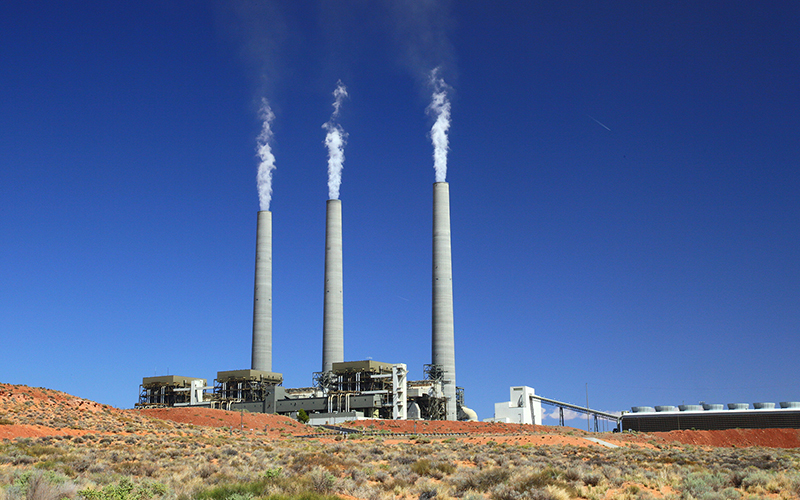
The Navajo Generating Station near Page burns locally mined coal to generate power for the Central Arizona Project, among other clients. Environmental groups have long criticized the plant for the level of pollutants it emits. (Photo by Bill Morrow/Creative Commons)
WASHINGTON – With record-low natural gas prices continuing to undercut coal, owners of the coal-fired Navajo Generating Station in Page could decide this spring whether they can afford to keep operating the plant or have to shut it down.
A shutdown would be at least two years off, but it would mean the loss of more than 800 jobs, most held by Navajo and Hopi workers, said officials at the Salt River Project, which operates the plant.
“The economics of the energy industry are changing rapidly and falling natural gas prices are changing how coal-fired power costs compare with other options,” said SRP spokesman Scott Harelson. “As a result, the owners of NGS are exploring every possible scenario with respect to the plant’s future and the impacts of those scenarios.
“That includes decommissioning the plant when the current lease ends in December 2019,” he said.
The plant’s owners, which include operator SRP, will have to decide this year if they want to decommission the plant in order to be out by 2019. Harelson said no decision has been made yet, but owners could decide on the future of the plant as soon as spring.
Besides being a source of jobs for the region, the Navajo Generating Station is also the primary source of power for the Central Arizona Project, which carries water from the Colorado River to Phoenix and Tucson. But CAP officials say that if the Navajo plant were to close down, they are confident they could find another source of power.
See related story:
“It could be whatever is out there, it could be natural gas, it could be solar, there are all sorts of options available,” said CAP Deputy General Manager Tom McCann.
Whatever replaces the Navajo Generating Station, McCann said it will not account for as much of the CAP’s power supply. The plant currently supplies 90 percent of CAP’s power, but no replacement would account for more than 15 or 20 percent of operations, he said.
Environmental officials, who have long criticized the Navajo Generating Station as one of the dirtiest in the West, said the current market could provide an opportunity to make the transition to renewable energy in the state.
“The Navajo Nation and the infrastructure accompanying these coal plants has tremendous potential to be repurposed and reused for renewable energy, including distributed solar,” said Michael Saul, senior attorney for the Center for Biological Diversity.
“I think one of the most important things from our perspective is that the Navajo Nation isn’t left in an unfair position of holding the bag for all the cleanup when these plants inevitably come to an end,” he said.
In December comments to the Bureau of Reclamation on the plant and the related Kayenta mining complex, the Center for Biological Diversity – along with the Sierra Club and the Grand Canyon Trust – said the Navajo Generating Station has dumped more than a half-billion tons of climate-changing gases into the atmosphere since the 1970s. Sierra Club officials say grassroots organizations have been advocating for a plan to transition away from coal for some time.
“There is great opportunities for renewable energy and clean energy and the jobs that can come with that as well,” said Sandy Bahr, director of the Sierra Club’s Arizona chapter.
“The economics of coal are keeping it in the ground. The economics of the plant do not warrant a continuing of operations past this next year,” Bahr said. “We want to see not just a movement away from coal, but other fossil fuels including natural gas.”
Because of its value to the Navajo Nation, Harelson said the tribe and the plant’s owners have made significant efforts to extend the life of the plant. Rep. Tom O’Halleran, D-Sedona, has also been involved, and said it is looking at all options.
“My staff and I are actively monitoring the situation at the Navajo Generating Station,” O’Halleran said in a statement from his office. “We are continuing to meet with stakeholders to determine the future of the plant. Investing in education and skills training will be a critical first step for the area if the closure cannot be avoided.”